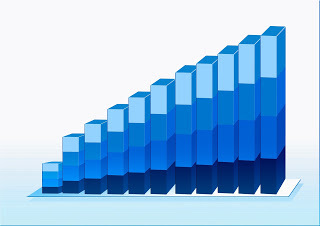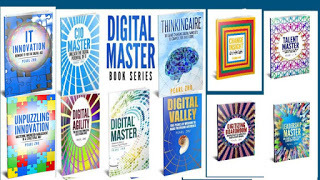Pearl Zhu's Blog, page 1267
December 22, 2016
CIOs as “Chief Improvement Officer”: Is your IT Organization in the Surviving, Striving or Thriving Mode?
 Organizations large or small are at the journey of digital transformation. IT plays an important role in leading changes. There is no one size fits all formula to run a high effective IT, because, different IT organizations and enterprise as a whole are at the different stage of business maturity, IT can be used as a support desk, a tool, an enabler, catalyzer, or a digital platform to meet the ultimate goal of an organization's short, medium, or long-term strategic plans. CIOs as “Chief Improvement Officer,” can you make an objective assessment whether your IT organization is in the surviving, striving or thriving mode? And how to transform IT from a cost center to a revenue generator and innovation hub?
Organizations large or small are at the journey of digital transformation. IT plays an important role in leading changes. There is no one size fits all formula to run a high effective IT, because, different IT organizations and enterprise as a whole are at the different stage of business maturity, IT can be used as a support desk, a tool, an enabler, catalyzer, or a digital platform to meet the ultimate goal of an organization's short, medium, or long-term strategic plans. CIOs as “Chief Improvement Officer,” can you make an objective assessment whether your IT organization is in the surviving, striving or thriving mode? And how to transform IT from a cost center to a revenue generator and innovation hub?
Surviving mode: Though information is growing exponentially and technologies are often the disruptive force behind digital transformation, the majority of IT organizations are still on the SURVIVING mode, get stuck at the lower level of maturity; many organizations still treat IT as a backend function that enables them to do day to day tasks and keeps the lights on. In most cases, the IT department isn't producing anything that is saleable and, therefore, many in the organization will view IT as something that seems to ceaselessly suck up money with the little-perceived return. Often time, IT organization is understaffed and overloaded, when IT takes orders from internal users only, it runs in a surviving mode; you have effectively become a commodity or being thought of as "unnecessary overhead" as well.
Striving mode: “Keeping the lights on” is always fundamental. However, to improve IT maturity, the forward-looking CIOs must be able to develop and optimize the IT operational function within itself. Being striving is to try to achieve the optimized result, and make strenuous effort on IT management effectiveness - to have IT resource aligned with the business strategies/ objectives; and IT efficiency -to have IT resources (people and operational IT processes) refined to the point that they are nimble, can adapt to changing business demands in a timely fashion, can be reapplied to altering business priorities and be effective with little down curve. IT will always have a role doing internal support. The trick is separating the internal actions so they run on "auto-mode," and having the CIO focus on managing a portfolio of strategic projects that have a quantifiable business return. It takes commitment and discipline to stay focused on the real priorities of the business instead of being distracted by what seems to be more urgent on any given day. The interesting point is that, once IT is unburdened from the daily routine of flipping the lights and break/fix; it’s almost natural that the staff turn into the striving mode to make continuous optimization, dig into the root causes, and become more goal focused and result driven.
 Thriving mode: At the higher mature stage, IT is thriving to grow vigorously, to flourish and become the game changer of the business. IT plays an innovation role as more of a proactive influencer. It is important to take advantage of the IT vantage point to surface ideas proactively, but it is even more important to work with business stakeholders to make sure they jointly own the idea before proceeding. IT should become the innovation co-creators that proactively generate ideas and then work with business partners to take those ideas forward. The challenge is getting out from the daily burden, but that requires creativity and some open and experienced leadership because money isn't always easy to come by. A great CIO with their finger on the pulse of technological advancement or information insight can provide many ideas on how new technology and abundance of information can create fresh new opportunities. Besides those macro, large-scale problems, at the intermediate or micro level, for either organization or individual, how do you get motivated to be innovative at daily basis via solving real world problems large or small, in a creative way? A thriving IT can make true differences and bring the competitive business advantage.
Thriving mode: At the higher mature stage, IT is thriving to grow vigorously, to flourish and become the game changer of the business. IT plays an innovation role as more of a proactive influencer. It is important to take advantage of the IT vantage point to surface ideas proactively, but it is even more important to work with business stakeholders to make sure they jointly own the idea before proceeding. IT should become the innovation co-creators that proactively generate ideas and then work with business partners to take those ideas forward. The challenge is getting out from the daily burden, but that requires creativity and some open and experienced leadership because money isn't always easy to come by. A great CIO with their finger on the pulse of technological advancement or information insight can provide many ideas on how new technology and abundance of information can create fresh new opportunities. Besides those macro, large-scale problems, at the intermediate or micro level, for either organization or individual, how do you get motivated to be innovative at daily basis via solving real world problems large or small, in a creative way? A thriving IT can make true differences and bring the competitive business advantage.
From “surviving to striving to thriving,” the importance of IT to the enterprise will increase, as the depth of their relationships with users throughout the enterprise. Enterprise IT organizations are likely to be winners on the whole, if IT and business can communicate and collaborate on creating the organization's vision, strategy, objectives, mission, and plans, to unleash the full digital potential and maximize the business deliveries.
Follow us at: @Pearl_Zhu
Published on December 22, 2016 22:32
December 21, 2016
The Monthly “Thinkingaire” Book Tuning The Set of Advanced Mindset to Lead Digital Transformation Dec. 2016
Leadership is the state of the mind.
 We have moved into the new digital age when information is abundant and where creativity becomes a baseline competence. The race of human against the machine is ongoing. The knowledge life cycle is significantly shortened, and the pace of information technology is so rapid that no one can rest on a static mindset, past accomplishments, or the wishful thought that everything is perfect the way it is. Indeed, the mindset is far more important than talent. Out-of-the-Box thinking is the metaphor of thinking creatively. Here are a set of blogs to brainstorm out-of-the-box thinking and thinkers.
We have moved into the new digital age when information is abundant and where creativity becomes a baseline competence. The race of human against the machine is ongoing. The knowledge life cycle is significantly shortened, and the pace of information technology is so rapid that no one can rest on a static mindset, past accomplishments, or the wishful thought that everything is perfect the way it is. Indeed, the mindset is far more important than talent. Out-of-the-Box thinking is the metaphor of thinking creatively. Here are a set of blogs to brainstorm out-of-the-box thinking and thinkers.
The Advanced Mindset to Lead Digital Transformation A Maturity Mind What is maturity basically? Is it a perception depending on our understanding? Or is there any scientific attribute which decides maturity level? Is it possible to develop maturity? Will it come automatically through the experience and people or is it gained over a period of time? Is it always true when you get older, you get more mature? How to decide a person's maturity level? It is subjective or is there any objective standard?
 A Creative Mind? Creativity is a mode of thinking. Some people are more in the creative thinking mode than others. This would mean that you can switch you thinking mode to fit the circumstances. That is the secret weapon of a 'creative mind,' to be able to voluntary switch between open and closed thinking styles. ?
A Creative Mind? Creativity is a mode of thinking. Some people are more in the creative thinking mode than others. This would mean that you can switch you thinking mode to fit the circumstances. That is the secret weapon of a 'creative mind,' to be able to voluntary switch between open and closed thinking styles. ?
An Adaptive Mind Adaptability is to be understood as the ability of a system to adapt itself efficiently and fast to changed circumstances. An adaptive mind is, therefore, an open mind that is able to adjust its thinking processes according to changes in its environment, or a learning mind to absorb all necessary knowledge and abstract it into insight and wisdom?
A Positive Mind The digital business environment becomes over complex and hyper-competitive, what’re the best and advanced minds to lead the business forward? A positive mind is on demand, why and what is it all about?
A Wise Mind? There is known known, known unknown and unknown unknown. To know what we don’t know is knowledge. We become intelligent / informative by knowing what we don’t know, and then we capture insight from the static knowledge and apply it to varying disciplines; ultimately the knowledge and insight can be abstracted into human wisdom which can be shared broadly and timelessly, also makes one humble enough to admit known unknown and unknown unknown. So a wise mind is not full, but free; not about cleverness, but about humbleness; not about system or boxes, but about out-of-box; not about informativeness, but about openness…..
The “Future of CIO” Blog has reached 1.6 million page views with about 3300+ blog posting in 59+ different categories of leadership, management, strategy, digitalization, change/talent, etc. The content richness is not for its own sake, but to convey the vision and share the wisdom. Blogging is not about writing, but about thinking; it’s not just about WHAT to say, but about WHY to say, and HOW to say it. It reflects the color and shade of your thought patterns, and it indicates the peaks and curves of your thinking waves. Unlike pure entertainment, quality and professional content takes time for digesting, contemplation and engaging, and therefore, it takes the time to attract the "hungry minds" and the "deep souls." It’s the journey to amplify your voice, deepen your digital footprints, and match your way for human progression.
Follow us at: @Pearl_Zhu
 We have moved into the new digital age when information is abundant and where creativity becomes a baseline competence. The race of human against the machine is ongoing. The knowledge life cycle is significantly shortened, and the pace of information technology is so rapid that no one can rest on a static mindset, past accomplishments, or the wishful thought that everything is perfect the way it is. Indeed, the mindset is far more important than talent. Out-of-the-Box thinking is the metaphor of thinking creatively. Here are a set of blogs to brainstorm out-of-the-box thinking and thinkers.
We have moved into the new digital age when information is abundant and where creativity becomes a baseline competence. The race of human against the machine is ongoing. The knowledge life cycle is significantly shortened, and the pace of information technology is so rapid that no one can rest on a static mindset, past accomplishments, or the wishful thought that everything is perfect the way it is. Indeed, the mindset is far more important than talent. Out-of-the-Box thinking is the metaphor of thinking creatively. Here are a set of blogs to brainstorm out-of-the-box thinking and thinkers.
The Advanced Mindset to Lead Digital Transformation A Maturity Mind What is maturity basically? Is it a perception depending on our understanding? Or is there any scientific attribute which decides maturity level? Is it possible to develop maturity? Will it come automatically through the experience and people or is it gained over a period of time? Is it always true when you get older, you get more mature? How to decide a person's maturity level? It is subjective or is there any objective standard?
 A Creative Mind? Creativity is a mode of thinking. Some people are more in the creative thinking mode than others. This would mean that you can switch you thinking mode to fit the circumstances. That is the secret weapon of a 'creative mind,' to be able to voluntary switch between open and closed thinking styles. ?
A Creative Mind? Creativity is a mode of thinking. Some people are more in the creative thinking mode than others. This would mean that you can switch you thinking mode to fit the circumstances. That is the secret weapon of a 'creative mind,' to be able to voluntary switch between open and closed thinking styles. ?
An Adaptive Mind Adaptability is to be understood as the ability of a system to adapt itself efficiently and fast to changed circumstances. An adaptive mind is, therefore, an open mind that is able to adjust its thinking processes according to changes in its environment, or a learning mind to absorb all necessary knowledge and abstract it into insight and wisdom?
A Positive Mind The digital business environment becomes over complex and hyper-competitive, what’re the best and advanced minds to lead the business forward? A positive mind is on demand, why and what is it all about?
A Wise Mind? There is known known, known unknown and unknown unknown. To know what we don’t know is knowledge. We become intelligent / informative by knowing what we don’t know, and then we capture insight from the static knowledge and apply it to varying disciplines; ultimately the knowledge and insight can be abstracted into human wisdom which can be shared broadly and timelessly, also makes one humble enough to admit known unknown and unknown unknown. So a wise mind is not full, but free; not about cleverness, but about humbleness; not about system or boxes, but about out-of-box; not about informativeness, but about openness…..
The “Future of CIO” Blog has reached 1.6 million page views with about 3300+ blog posting in 59+ different categories of leadership, management, strategy, digitalization, change/talent, etc. The content richness is not for its own sake, but to convey the vision and share the wisdom. Blogging is not about writing, but about thinking; it’s not just about WHAT to say, but about WHY to say, and HOW to say it. It reflects the color and shade of your thought patterns, and it indicates the peaks and curves of your thinking waves. Unlike pure entertainment, quality and professional content takes time for digesting, contemplation and engaging, and therefore, it takes the time to attract the "hungry minds" and the "deep souls." It’s the journey to amplify your voice, deepen your digital footprints, and match your way for human progression.
Follow us at: @Pearl_Zhu
Published on December 21, 2016 21:36
CIOs as “Chief Influence Officer”: The CIO’s Triple Digital influence
 Due to the complex nature of the technology and exponential growth of information, digital CIOs also need to mastering at multidimensional thinking and build multilevel of professional capabilities. The successful CIOs need to not only know the IT side of knots and bolts but also have to understand the business’s pains and gains. The priority for CIOs is to genuinely position IT as an integral and inseparable part of the business, to improve overall business effectiveness, agility, and maturity via practicing triple digital influence.
Due to the complex nature of the technology and exponential growth of information, digital CIOs also need to mastering at multidimensional thinking and build multilevel of professional capabilities. The successful CIOs need to not only know the IT side of knots and bolts but also have to understand the business’s pains and gains. The priority for CIOs is to genuinely position IT as an integral and inseparable part of the business, to improve overall business effectiveness, agility, and maturity via practicing triple digital influence.
As IT leader, CIOs need to have the technological vision and awareness: As more often than not, technology becomes the game changer and innovation driver for businesses. A CIO’s technological vision should be attainable subject to current times and its ability to adapt to changing times and help the business gain the competitive advantage for the long term. Vision should have a direction which sets in clarity. Setting a vision that isn't high enough doesn't challenge the organization to excel. But establishing a vision that is based on unrealistic expectations will discourage the team’s morality. The role of modern CIO is to identify and blend the ways that information and technology can assist and shape the business by linking all digital aspects together to enforce the value creation; these are then mixed with other ingredients to create products and process which generate differentiated value for their business’s long-term growth.
The digital CIO is a business conductor: CIOs need to cover the business dimension as well as the technology dimension with their teams. In real terms, the role of CIO is to carry forward the business via leveraging the available technology for transformation and furthering the business. The CIO needs to provide unique business insight as they usually oversee key business processes. If you see your business as an "asset under construction," then the CIO is not only responsible for cost but is the enabler and architect of new business value. CIOs need to lead the department so that every level of the organization has great working relationships with the IT teams. Making a connection with other people around the management/board table is all about talking their language. Identify the key performance indicators of the company and detail how your initiatives will drive improvements in the current state. And the most "engaged" CIOs need to be confident that their IT is totally integrated and IT is the business. The CIO is a trusted advisor to the Board, and increasingly, the CIO can be part of the Board. As such, the CIO has to be a productive member and provide some active insight and options.
 The digital CIO as “Chief Innovation Officer” to propose and manage new ideas: IT is an important element in building innovation capabilities in any organization today. CIOs are expected to constantly propose new ideas and challenging the status quo. IT leaders need to identify the issues associated with innovation in an enterprise and actually have developed a unique model and platform for managing innovation portfolio in a systematic way. IT leaders are often at the right position to oversee business processes and identify the critical business issues by working closely with a business partner from a long-term perspective, and leverage technology to manage innovation across the enterprise boundary. Digital IT is a paradigm shift in role, responsibility, and attitude. CIOs who are only putting stress on "have the knowledge" not on "build the knowledge" might be in danger just to preserve the organization and thus create huge constraints for the possible innovation. A confident CIO needs to keep asking thought-provoking questions, to manage a healthy innovation portfolio, with incremental innovation in optimizing business processes, as well as disruptive innovations with structure in renovating business model and upcoming business expansion.
The digital CIO as “Chief Innovation Officer” to propose and manage new ideas: IT is an important element in building innovation capabilities in any organization today. CIOs are expected to constantly propose new ideas and challenging the status quo. IT leaders need to identify the issues associated with innovation in an enterprise and actually have developed a unique model and platform for managing innovation portfolio in a systematic way. IT leaders are often at the right position to oversee business processes and identify the critical business issues by working closely with a business partner from a long-term perspective, and leverage technology to manage innovation across the enterprise boundary. Digital IT is a paradigm shift in role, responsibility, and attitude. CIOs who are only putting stress on "have the knowledge" not on "build the knowledge" might be in danger just to preserve the organization and thus create huge constraints for the possible innovation. A confident CIO needs to keep asking thought-provoking questions, to manage a healthy innovation portfolio, with incremental innovation in optimizing business processes, as well as disruptive innovations with structure in renovating business model and upcoming business expansion.
Digital CIOs are the leadership role, not just transactional manager. The forward-looking organizations have to empower their CIOs and engage them in the core business agenda and strategy planning, and CIOs have to proactively work with business partners via practicing triple digital influence. And they have to progressively transform IT into a high-performing and high-mature innovation engine, to deliver the business solution and even game-changing for catalyzing strategy execution and long-term growth.
Follow us at: @Pearl_Zhu
Published on December 21, 2016 21:30
December 20, 2016
CIOs as “Chief Inquisitive Officer: A set of Q&As CIOs’ Challenges and Priority (III)
 Modern CIOs face many challenges, it is not sufficient to only keep the lights on. Regardless of which industry or the nature of organization you are in, being a digital leader will need to master the art of creating unique, differentiating value from piles of commoditized technologies and take advantage of the emergent digital trend as well; digital CIOs also have multiple personas, “Chief Innovation Officer,” “Chief Insight Officer,” “Chief Improvement Officer,” “Chief Information Officer,” and here, we discuss CIOs as “Chief Inquisitive Officer,” with a set of Q&As to lead digital transformation.
Modern CIOs face many challenges, it is not sufficient to only keep the lights on. Regardless of which industry or the nature of organization you are in, being a digital leader will need to master the art of creating unique, differentiating value from piles of commoditized technologies and take advantage of the emergent digital trend as well; digital CIOs also have multiple personas, “Chief Innovation Officer,” “Chief Insight Officer,” “Chief Improvement Officer,” “Chief Information Officer,” and here, we discuss CIOs as “Chief Inquisitive Officer,” with a set of Q&As to lead digital transformation.
Q11: What are CIO’s “To Do” list put on the top of the business agenda : Nowadays, information is the lifeblood of business, and technology is the big brain of the organization, there are so many things in CIO’s agenda, IT is always in overload mode, and CIOs seem to be at hot seat. Therefore, in order to run IT more effectively and efficiently, how shall CIOs prioritize the projects, and what shall be put on the top of CIO’s agenda?
Q12: How to the Right Priorities for Running Digital IT with Full Speed? IT plays a significant role in the digital transformation of the organization because information is permeating into every corner of the business and technology is often the disruptive force of innovation. However, the majority of IT organizations get stuck in the lower level of maturity, overloaded and understaffed, slow to change, and operate in a "surviving mode." How to set the right priority to thrive and run digital IT with the full speed.
Q13: What are the CIO’s Top Priorities to Run a Digital IT? There is no doubt information is the lifeblood of business and IT plays a more critical role in any sector of organizations today. However, there is still a long way to go for IT to reach the next level of maturity, from reactive to proactive, from alignment to enablement, and from a cost center to a value creator. From IT management perspective, why don't more CIOs have a real seat at the big table? Why does the disconnect exist between the business and IT that fosters many of these concerns? And what are the CIO’s top priorities today to run a high-effective and high-innovative digital IT?
Q14: How to Strike the Right Balance between “Keeping the Lights on” and Growing your Business? Due to the limited budget and resource, most of the organizations, especially those legacy companies always struggle with keeping the light on and changing or transforming their business. Is “running a business” always your first priority, when is strategic execution more important than keeping the lights on? Optimally, how to strike the right balance between “keeping the light on" and growing your business?
 Q15: Where are the CIO’s Real Challenges in Digital Transformation? Digital provides significant opportunities for business growth, also brings unprecedented risks to cause business fall. Never before has IT and business been so closely tied together. Never before has technology moved more quickly and missteps have larger trajectory impacts on every aspect of the business.
Q15: Where are the CIO’s Real Challenges in Digital Transformation? Digital provides significant opportunities for business growth, also brings unprecedented risks to cause business fall. Never before has IT and business been so closely tied together. Never before has technology moved more quickly and missteps have larger trajectory impacts on every aspect of the business.
The digital CIOs reimagine IT as the business growth engine and lead changes via inquiries. A confident CIO needs to keep asking open-ended questions such as, "Why? Why not? What If?" They have to focus on guiding the company through the digital transformation, and create unique business value because IT is the significant element of any differentiated business capability and the defining factor for competitive advantage.
Follow us at: @Pearl_Zhu
Published on December 20, 2016 22:54
Five Stages from “Doing Digital” to “Being Digital”
 Organizational digitalization is not just about using the latest technology gadgets or using the fancy tools. At the high maturity level, organizations have to stretch out in every business dimension for driving the full-fledged digital transformation. There are a couple of evolutional ecosystem stages businesses have to experience in order to move up the learning curve, from “Doing Digital,” to “Being Digital.”
Organizational digitalization is not just about using the latest technology gadgets or using the fancy tools. At the high maturity level, organizations have to stretch out in every business dimension for driving the full-fledged digital transformation. There are a couple of evolutional ecosystem stages businesses have to experience in order to move up the learning curve, from “Doing Digital,” to “Being Digital.”
The BASIC paradigm of the ecosystem needs being worked out; Digital transformation is the long journey with many bumps and curves on the way. It is important in helping leaders define the vision, discover the blind spots, identify unknowns , and then consciously manage the communication gap between self-perception and the perception of others. Transforming, generating, ascending and core-shifting individuals, teams, even whole the organization! That's the starting point. When the need for significant change is identified, it's generally naive to think it will succeed without transformation as well. The digital transformation is mainly the dynamic problem-framing and problem-solving continuum. Every serious problem we face today as a species has been caused by the certain level of dysfunction. And human dysfunction are caused by the interaction of hidden (intangible and invisible) human affective, cognitive, imaginative and connotative functions and content. In other words, the wrong focus, the wrong assumptions, the wrong ends, and the wrong means. When these hidden human functions and content are wrong, you are in the downfall spiral. Hence, the basic digital paradigm shift is to understand the real problems and start solving them in the right way.
The digital ecosystem EXPANDs when the business community broaden its scope and consumes all sorts of resources: Digital is about hyperconnectivity and interdependence. The emergence of potential opportunities for exploiting digitization is likely to follow a nonlinear pattern as the pervasiveness of an organization's digitization journey increases. An digital organization is an organic system: It will be organized as an organic system, with cells that have a function, an infrastructure for input and output and for signaling, a “brain” to process information, generate ideas, and make decisions. How these ideas are recognized, filtered and dealt with will become a crucial factor in an organization's success in producing digitized products and services, enhancing its competitive business capabilities, and expanding its influence with the ability to co-create in a digital ecosystem -treats customers, channel partners, suppliers, and industry ecosystem participants as active agents who have permission to combine the modular capabilities exposed in a platform to create new experiences and expand its impact.
Today’s digital dynamic enables companies to leverage their various environments, or ecosystems, to chase INNOVATION and accelerate performance: The hyper-connecting nature of digital offers particularly fertile ground for developing cross-industry ecosystems and innovation opportunities, in part because ways of doing business and customer expectations both tend to be more flexible than the siloed industrial age, and companies need new ecosystem partners to pursue them. The dynamic digital organization needs to be an innovation powerhouse in which creativity is encouraged, and innovative problem-solving via cross-functional collaboration is the new normal. If you look at a business as a collection of subsystems, in simplest terms, the organizational factors are how those subsystems are structured within the larger system and how they interact with each other. Those interactions can be technical, informational, human, or structural, to name a few.
Organizations and their people learn through their INTERACTION with the environment: They act, observe the consequences of their action, make inferences about those consequences, and draw implications for future action Encourage people to think in bigger boxes" (think outside of your job description and consider company and industry and even societal impacts). The dynamic and enrich interaction can accelerate performance and talent multiplication to harness innovation capability. The key point is that more and more creativity and innovation is a matter of survival in the long term for any organization, and lead into the creativity economy at the macro level.
 Digital organizations need to keep evolving, renewing, and achieving the state of dynamic balance: The digital paradigm shift is inevitable. The real power of social technology comes from the innate appeal of interacting socially and intellectual stimulation that people derive from sharing what they know, expressing opinions and learning what others know and think. Organizations today need to constantly improve the business and seeing change as an opportunity while keeping a holistic overview of the business are the core messages of the text. To achieve such a state of dynamic balance, a radically different social and economic structure will be needed. So the organization of the future starts with a changing nature. The dynamic design allows the organization to morph as life conditions and organizational capacities change to allow better fit for the purpose. And, when that purpose is fulfilled, or a more compelling purpose appears, then the organization can morph again and move on to the next great purpose. It keeps evolving in a healthy life cycle to achieve the state of dynamic balance
Digital organizations need to keep evolving, renewing, and achieving the state of dynamic balance: The digital paradigm shift is inevitable. The real power of social technology comes from the innate appeal of interacting socially and intellectual stimulation that people derive from sharing what they know, expressing opinions and learning what others know and think. Organizations today need to constantly improve the business and seeing change as an opportunity while keeping a holistic overview of the business are the core messages of the text. To achieve such a state of dynamic balance, a radically different social and economic structure will be needed. So the organization of the future starts with a changing nature. The dynamic design allows the organization to morph as life conditions and organizational capacities change to allow better fit for the purpose. And, when that purpose is fulfilled, or a more compelling purpose appears, then the organization can morph again and move on to the next great purpose. It keeps evolving in a healthy life cycle to achieve the state of dynamic balance Doing digital is about taking a few actions; and being digital is the fundamental shift from the mindset to behavior. Consider digital organization as the self-organized but interlaced environments, and humans are vehicles of natural and cultural solutions. From the economic and organizational point of view, people are able to adapt themselves and their organization through a collaborative approach for understanding, learning, accelerating performance, and innovating. Follow us at: @Pearl_Zhu
Published on December 20, 2016 22:51
December 19, 2016
The Monthly Foresight: The Vision Thing Dec. 2016
 Vision is about having a positive outlook on the future that is not predicated on the past or present. The vision needs to be a good metaphor - 'the guiding light,' so that people can see themselves and their work reflected in it. There is also a passionate connection to a vision. When a vision is realized, people live with change.
Vision is about having a positive outlook on the future that is not predicated on the past or present. The vision needs to be a good metaphor - 'the guiding light,' so that people can see themselves and their work reflected in it. There is also a passionate connection to a vision. When a vision is realized, people live with change.
Five Views from the Vision: Vision is to zoom into the future as if it were closer. Organizations large or small are at the journey of digital transformation, therefore, the vision thing does matter, it is one of the important leadership traits for driving to the right directions. More specifically, which views do leaders see or perceive via their visions?
Is Vision Statement Overrated? Vision Statement is a very brief summary to provide guidance about what core to preserve and what future to stimulate progress toward. It gives some sense of the two main points. First, it's doing it to having the conversations across the organization. Second, it's worth pushing to a level of specificity, which makes the desired outcome unarguably clear and provides a means of tracking progress. One of the key payoffs from this process is that it delivers the top team a single-page matrix of their current and future desired states. This becomes the starting point for their detailed planning - and, of course, some readjustments as they tested the various elements through detailed analysis.
Are Visionary CIOs Often Outliers? Modern CIOs have multiple personas, they have to wear different hats to fit the roles situationally in order to lead effectively. Technology is complex, business is complex, and people are complex. Due to increasing changes in the digital dynamic environment, The CIOs needs to be a dynamic person with vision, open, growth and complexity mindset- with high ability to envision the digital trends, manage innovations, communicating to suite situations so as to craft strategies and make things happen. Visionary CIOs are in demand, and, are visionary Who are they, and what can they do to drive digital transformation of the business.
A Visionary Board The corporate board plays a significant leadership role in modern businesses, with multidimensional responsibilities, such as strategy oversight, policy setting, corporate governance and monitoring - accountabilities of the environment - regulatory, shareholder, etc. Not only do today’s BoDs need to have sufficient knowledge to understand the business ecosystem, but also they should have the business vision to predict the emergent trend of business, technology or industry, so they can guide the executive team toward the right direction and play the management advising role effortlessly
 Is Digital Leadership all about Vision? As businesses and the world move deeper and deeper into the digital world of VUCA -volatility, uncertainty, complexity, and ambiguity, leaders of any organization, large or small, must capture the foresight of digitalization, gain the insight upon globalization, and become knowledgeable about the terrain of the hyper-connected land out there. More specifically, leaders need to have a clear vision to zoom into the future and broadened knowledge to zoom out the reality, in order to guide the business through the digital transformation. However, is digital leadership all about vision?
Is Digital Leadership all about Vision? As businesses and the world move deeper and deeper into the digital world of VUCA -volatility, uncertainty, complexity, and ambiguity, leaders of any organization, large or small, must capture the foresight of digitalization, gain the insight upon globalization, and become knowledgeable about the terrain of the hyper-connected land out there. More specifically, leaders need to have a clear vision to zoom into the future and broadened knowledge to zoom out the reality, in order to guide the business through the digital transformation. However, is digital leadership all about vision?
The blog is a dynamic book flowing with your thought; growing through your dedication; sharing your knowledge; conveying your wisdom, and making influence through touching the hearts and connecting the minds across the globe. The “Future of CIO” Blog has reached 1.5 million page views with about #3100 blog posting. Among 59+ different categories of leadership, management, strategy, digitalization, change/talent, etc. Blogging is not about writing, but about thinking and innovating the new ideas; it’s not just about WHAT to say, but about WHY to say, and HOW to say it. It reflects the color and shade of your thought patterns, and it indicates the peaks and curves of your thinking waves. Unlike pure entertainment, quality and professional content takes time for digesting, contemplation and engaging, and therefore, it takes the time to attract the "hungry minds" and the "deep souls." It’s the journey to amplify diverse voices and deepen digital footprints, and it's the way to harness your innovative spirit.
Follow us at: @Pearl_Zhu
Published on December 19, 2016 22:28
Three Performance Indicators for Keeping IT and the Business at the Same Page
 Forward-looking IT organizations are on the journey of digital transformation. Keep in mind of the management mantra -”You can only manage what you measure.”CIOs need to keep a measure and periodicity at which the measure is reviewed against setting targets. Then ensure IT raises the bar on a continual basis to ensure the stakeholders get a real picture of how well the IT efforts are bearing desired results and keep IT and the business on the same page for accelerating digital transformation.
Forward-looking IT organizations are on the journey of digital transformation. Keep in mind of the management mantra -”You can only manage what you measure.”CIOs need to keep a measure and periodicity at which the measure is reviewed against setting targets. Then ensure IT raises the bar on a continual basis to ensure the stakeholders get a real picture of how well the IT efforts are bearing desired results and keep IT and the business on the same page for accelerating digital transformation.
IT Improvement Indicator: CIOs with improvement mindset continually looking to optimize processes and improve customer satisfaction. Identify the key performance indicators of the company and detail how your initiatives will drive improvements in the current state. An effective CIO’s job is to improve operations to reduce the burden on the company while trying to stay current with ever-changing information and technologies. That includes reducing costs, improving systems, streamlining processes and providing continually expanding services/solutions. "Continual improvement" is IT mantra in the digital era; there is never an "enough" to optimizing operations. However, optimization of technology should not be the be-all and end-all at the expense of the health of the overall organization.improvement programs are always underway, talent gaps constantly break out as staff leave or as the business moves in new strategic directions. The objective is to recognize what needs to be done, to assess how well things are being done, to assign and reassign priorities to what needs to be done and to invest in improvements in a mindful way.
IT Innovation Indicator: CIOs with the growth mindset will keep looking for the new opportunities to improve end customer retention and revenue growth. Focus on the vision set out by the Board - draw a picture of how and what the CIO’s doing will help achieve the vision. Leading only with operational considerations is not the way forward. It needs to be accomplished by working with business partners to leverage opportunities for changing how the business competes in the marketplace. Rather than wait for the business to tell IT what they want, IT needs to proactively work with the business and partners upon the great new digital technologies which can change the business. It means IT has to experiment the better way to do things, encourage creativity because digital transformation efforts need to be undertaken as the means of getting to a defined differentiated capability to accomplish a defined goal. Aligning IT innovation (ultimately the business innovation) with desired corporate strategic outcomes, by implementing excellent IT Financial, Demand, and Asset management processes, prioritize innovation initiatives in alignment with corporate strategy and then measures that the IT portfolio is being optimally maintained through effective benefits management programs.
 IT Investment Indicator: Visionary IT leaders also focus on the long-term vision vs. quick win etc. It takes a strong CIO to convince management to continue IT investment to maintain the nimble state. Unfortunately, many executives see that once IT reaches that state of "can do it," now want to start to milk the process but stop the IT investment. IT efficiency and effectiveness is an ever evolving state and sometimes it takes larger and not incremental investments to reach desired positions. Like any C-suite members, CIOs have to participate in forming the organization's strategy, its implementation, and assessing its performance. They have to make sure that all IT investments are aligned with the organization's strategy and the approved priorities. The three keys to presenting IT value are financial returns, return timeline, and risk: Just like any other investment. If you can present IT portfolio in a manner similar to an investment portfolio, it makes instant conceptual sense to board and C-level folks. Once you start prattling on about IT-centric metrics you've lost your audience. If you can show the objective of the investment and the three elements above, you can present IT as a value generator rather than a cost center.
IT Investment Indicator: Visionary IT leaders also focus on the long-term vision vs. quick win etc. It takes a strong CIO to convince management to continue IT investment to maintain the nimble state. Unfortunately, many executives see that once IT reaches that state of "can do it," now want to start to milk the process but stop the IT investment. IT efficiency and effectiveness is an ever evolving state and sometimes it takes larger and not incremental investments to reach desired positions. Like any C-suite members, CIOs have to participate in forming the organization's strategy, its implementation, and assessing its performance. They have to make sure that all IT investments are aligned with the organization's strategy and the approved priorities. The three keys to presenting IT value are financial returns, return timeline, and risk: Just like any other investment. If you can present IT portfolio in a manner similar to an investment portfolio, it makes instant conceptual sense to board and C-level folks. Once you start prattling on about IT-centric metrics you've lost your audience. If you can show the objective of the investment and the three elements above, you can present IT as a value generator rather than a cost center.
CIOs need to be able to listen to a wide range of opinions and approaches and understand how that might benefit the business. Select the right set of indicators (Improvement, Innovation, and Investment), and measure them effectively; also include a broad range of monitoring, performance measurement, performance reporting, make sure IT and business are always on the same page. IT metrics need to evolve to something that matters to the business audience, at the same time that "business sentiment" needs to get put into something more tangible.
Follow us at: @Pearl_Zhu
Published on December 19, 2016 22:24
December 18, 2016
The Popular Quotes Collection V in “Digital Master” Book Series
 “Digital Master” is the series of guidebooks (11+ books) to perceive the multifaceted impact digital is making to the business and our society, help forward-thinking organizations navigate through the digital journey in a systematic way, and avoid “rogue digital.” Here is the set of popular quotes for conveying the digital vision and sharing the unique insight about the digital transformation.
“Digital Master” is the series of guidebooks (11+ books) to perceive the multifaceted impact digital is making to the business and our society, help forward-thinking organizations navigate through the digital journey in a systematic way, and avoid “rogue digital.” Here is the set of popular quotes for conveying the digital vision and sharing the unique insight about the digital transformation.
 It Innovation: Reinvent It for the Digital Age by Pearl Zhu
It Innovation: Reinvent It for the Digital Age by Pearl Zhu
“An outlier does not lack knowledge but has the interdisciplinary understanding to see things differently.” ― Pearl Zhu, It Innovation: Reinvent It for the Digital Age
“Innovation is the art at the eyes of the artist; the science at the mind of the scientist; and the bridge between the art and science.” ― Pearl Zhu, Digital Master
“The industrial-based enterprise of the 20th century had run out of gas, and the digital enterprise of the 21st century has the new characteristics and DNA of innovation.” ― Pearl Zhu, It Innovation: Reinvent It for the Digital Age
“Innovation becomes simply “creating value by solving simple or complex problems.” ― Pearl Zhu, It Innovation: Reinvent It for the Digital Age
 Thinkingaire: 100 Game-Changing Digital Mindsets to Compete for the Future by Pearl Zhu
Thinkingaire: 100 Game-Changing Digital Mindsets to Compete for the Future by Pearl Zhu
“Wisdom is the intelligent use of our knowledge, whereas sensibility is an intelligent use of our judgment.” ― Pearl Zhu, Thinkingaire: 100 Game Changing Digital Mindsets to Compete for the Future
“Clarity is a perception; it’s an emotional alignment of thoughts, intuitions, inclinations, expression and expectations.” ― Pearl Zhu, Thinkingaire: 100 Game Changing Digital Mindsets to Compete for the Future
“A flexible mind has a better chance to think differently and take a unique path in the life journey.” ― Pearl Zhu, Thinkingaire: 100 Game-Changing Digital Mindsets to Compete for the Future
 CIO Master: Unleash the Digital Potential of It b
CIO Master: Unleash the Digital Potential of It b
“A problem-solving mind focuses on keeping the end in mind, to solve PROBLEMS in optimal ways.” ― Pearl Zhu, CIO Master: Unleash the Digital Potential of It
“One of the most influential aspects of people's psychology is how they perceive the world around them and how they relate to it.” ― Pearl Zhu, CIO Master: Unleash the Digital Potential of It
“IT can coordinate all necessary business elements, either hard or soft, to orchestrate a digital symphony.” ― Pearl Zhu, CIO Master: Unleash the Digital Potential of It
 Leadership Master: Five Digital Trends to Leap Leadership Maturity by “Authenticity is the most fundamental, but challenging attribute for leadership.” ― Pearl Zhu, Leadership Master: Five Digital Trends to Leap Leadership Maturity
Leadership Master: Five Digital Trends to Leap Leadership Maturity by “Authenticity is the most fundamental, but challenging attribute for leadership.” ― Pearl Zhu, Leadership Master: Five Digital Trends to Leap Leadership Maturity
“A wise leader doesn’t just follow but discover the path.” ― Pearl Zhu, Leadership Master: Five Digital Trends to Leap Leadership Maturity
“Innovative leadership is essentially anchored on the leader’s overall multifaceted resourcefulness and multidimensional competencies.” ― Pearl Zhu, Leadership Master: Five Digital Trends to Leap Leadership Maturity
“It seems to be most leaders have more conventional wisdom, but creative leaders have better common sense.” ― Pearl Zhu, Leadership Master: Five Digital Trends to Leap Leadership Maturity
 Digitizing Boardroom: The Multifaceted Aspects of Digital Ready Boards by Pearl Zhu“A steer may not accelerate the speed of vehicle directly; by navigating the better path, it can shorten the distance or save the energy to reach the right destination.” ― Pearl Zhu, Digitizing Boardroom: The Multifaceted Aspects of Digital Ready Boards
Digitizing Boardroom: The Multifaceted Aspects of Digital Ready Boards by Pearl Zhu“A steer may not accelerate the speed of vehicle directly; by navigating the better path, it can shorten the distance or save the energy to reach the right destination.” ― Pearl Zhu, Digitizing Boardroom: The Multifaceted Aspects of Digital Ready Boards
“Sense and deal with problems in their smallest state, before they grow bigger and become fatal.” ― Pearl Zhu, Digitizing Boardroom: The Multifaceted Aspects of Digital Ready Boards
“The BoDs play the significant role in both Management Innovation and Innovation Management.” ― Pearl Zhu, Digitizing Boardroom: The Multifaceted Aspects of Digital Ready Boards
“The Board must set a tone for digital leadership.” ― Pearl Zhu, Digitizing Boardroom: The Multifaceted Aspects of Digital Ready Boards
Follow us at: @Pearl_Zhu
Published on December 18, 2016 23:03
The Multitude of IT focus at the Era of Digital Renaissance
 Digital transformation represents a break with the past, with a high level of impact and complexity. Transformation efforts need to be undertaken as the means of getting to a defined different capability to accomplish a set of defined business goals. IT plays a critical role in catalyzing the digital shift. At the digital age, CIOs need to be both digital masters and innovation champions, to run IT with the multitude of focus at the era of digital renaissance.
Digital transformation represents a break with the past, with a high level of impact and complexity. Transformation efforts need to be undertaken as the means of getting to a defined different capability to accomplish a set of defined business goals. IT plays a critical role in catalyzing the digital shift. At the digital age, CIOs need to be both digital masters and innovation champions, to run IT with the multitude of focus at the era of digital renaissance.
CIOs need to be digital masters to connect those enterprise dots for improving business competency: With increasing pace of changes and fierce competitions, it is increasingly more challenging for IT to deliver to business what it wants when it wants. By the time IT is ready to deliver functionality to the business, the business needs, not just "requirements," have already changed. In most of the organizations, IT is setting back and waiting for the request. IT has to be configured in a way to understand the business and to deliver the business and market need. To lead digital transformation in a proactive way, CIOs needs to switch the focus from inside-out operation-driven to outside-in customer focused. CIOs must become true business leaders by looking to get much closer to their company’s customers in understanding their needs, and ask big “WHYs” to help clarify their companies’ “what,” and IT’s “how.” Few executives, if any, have the visibility across the enterprise like a CIO, to connect the dots of the business because all of those dots are internal customers of IT. IT can weave all those hard and soft elements into differentiated business competency. There is no one size fits all formula to run a high effective IT, because, different IT organizations and enterprise as a whole are at the different stage of business maturity, IT can be used as a tool, enabler, catalyzer, or a digital integrator & transformer to meet the ultimate goal of an organization for the long run. IT do the connecting with business and technology solutions, and bridging the gap between IT and the business is really the issue of leveraging processes, tools and products that organizations use to effect the digital transformation from strategy to deployment and improve business competency and maturity.
CIOs need to be information masters to improve IT speed the overall business responsiveness: The CIO is not just managing IT to keep the lights on but is managing the information to enable enterprises becoming nimble, smart, and gain the competitive edge, to ensure the right people getting the right information in the right position for making the right decisions and solving the right problems. The digital CIO should focus on the information content and context; how that information can be tapped from the underlying data and be utilized to turn it into valuable business foresight and customer insight, and how the information and insight can be penetrated through the business and be actively used in managing business processes and building business capabilities to execute business strategy solidly. More and more businesses expect the consumerization style responsiveness from IT, many CIOs have encountered an IT consumerization mentality (“I want what I want when I want it”) in organizations, CIOs as information masters need to break down silos and keep information flow across functional boundaries seamlessly to allow for the digital speed, and it is perceived as a changing organization to get things done quickly, not the overhead.
 CIOs need to be innovation masters to handle the “spinning plates” well and manage a balanced innovation portfolio: Many IT leaders and IT organizations are at the crossroad, either becoming a “Chief Innovation Officer” to run IT as an innovation hub of the business; or turns to be “Chief Irrelevant Officer” without the seat at the big table. Digital is the age of options, it provides the opportunity to think the new way to do things, so it forces IT leaders to get really creative in how they architect and implement changes and manage innovation, to ensure that IT is strategically positioned to be ahead of where the business is moving next. IT should shift its role as the business consultative advisor so they can open out ideas since they will be looking for the business’s pains and solutions that IT can drive. Running digital IT is more link spinning plates, you need to have multiple focuses, but also create synergy to manage a balanced innovation portfolio. IT leaders need to handle the “plate load” effectively, all with the brand quality and emphasis on progress and continuous delivery. The sooner you finish your existing commitments, the sooner you can launch new innovation initiatives. The spinning plates are one aspect of multiple teams are expected to work on what they can do at once, but there are strategies for focusing so that progress will occur by most beneficial impacts, firm commitments or on-time and on value delivery.
CIOs need to be innovation masters to handle the “spinning plates” well and manage a balanced innovation portfolio: Many IT leaders and IT organizations are at the crossroad, either becoming a “Chief Innovation Officer” to run IT as an innovation hub of the business; or turns to be “Chief Irrelevant Officer” without the seat at the big table. Digital is the age of options, it provides the opportunity to think the new way to do things, so it forces IT leaders to get really creative in how they architect and implement changes and manage innovation, to ensure that IT is strategically positioned to be ahead of where the business is moving next. IT should shift its role as the business consultative advisor so they can open out ideas since they will be looking for the business’s pains and solutions that IT can drive. Running digital IT is more link spinning plates, you need to have multiple focuses, but also create synergy to manage a balanced innovation portfolio. IT leaders need to handle the “plate load” effectively, all with the brand quality and emphasis on progress and continuous delivery. The sooner you finish your existing commitments, the sooner you can launch new innovation initiatives. The spinning plates are one aspect of multiple teams are expected to work on what they can do at once, but there are strategies for focusing so that progress will occur by most beneficial impacts, firm commitments or on-time and on value delivery.
The CIO must be concerned as to whether the operational ecosystem will function as expected. Business is reliance on IT as a force multiplier, IT needs to be proactive, not reactive. Increasingly the CIO looks to play a role of supplementing the business vision with technology as the accelerator and innovator. So information management, innovation, and digital transformation, IT needs to play them all well.
Follow us at: @Pearl_Zhu
Published on December 18, 2016 22:59
December 17, 2016
The Monthly CIO Debates Collection: Bridging the Gaps between Business and IT Dec. 2016
Debating is not for stimulating conflicts, but for brainstorming better ways to do things.
 Due to the changing nature of technology, IT leadership role also continues to involve & shift the focus, to move up the maturity level. More and more CIOs are requested to take more responsibility and many CIOs present the breadth of leadership competency. The proactive IT debates help IT leaders to brainstorm innovative and better ways to do things, and improve management capabilities. Here are the monthly CIO debates collections for Nov. 2016.
Due to the changing nature of technology, IT leadership role also continues to involve & shift the focus, to move up the maturity level. More and more CIOs are requested to take more responsibility and many CIOs present the breadth of leadership competency. The proactive IT debates help IT leaders to brainstorm innovative and better ways to do things, and improve management capabilities. Here are the monthly CIO debates collections for Nov. 2016.
Is Business & IT Gap ‘Artificial’ The “gap” between business and IT is always a hot debate, and the conclusion is also controversial, some say, the gap is definitely shrinking, as IT is gradually becoming engrained into every aspect of business these days due to the internet, technology developments etc. The clear cut divide that used to be there between IT and business in the olden days is vanishing fast; the opposite opinion is that indeed the gap is deepened because the “shadow IT”-business bypassing IT oversight to order SAAS service on their own, causes serious governance issue and communication gaps.?
How Should CIO respond to endless internal customer demand for IT solutions? Modern IT needs to both take care of internal customers by meeting their needs, and to delight end customer by optimizing digital touch points; it has to both map out the strategic projects, but also to keep the light on. How should CIOs prioritize the limited time and resources to ascend IT maturity, and how should CIOs respond to endless internal customer demand for IT solutions?
Is the Gap between Business and IT Shrinking? IT is better integrated with the business than ever before. However, IT remains quite distinct in terms of performance metrics, structure, career path, etc. there are still numerous debates about “He said, She said” in CIO forums, Is the gap between business and IT shrinking?

The “Future of CIO” Blog has reached 1.5 million page views with 3300+ blog posting in 59+ different categories of leadership, management, strategy, digitalization, change/talent, etc. blog posting. The content richness is not for its own sake, but to convey the vision and share the wisdom. Blogging is not about writing, but about thinking and innovating the new ideas; it’s not just about WHAT to say, but about WHY to say, and HOW to say it. It reflects the color and shade of your thought patterns, and it indicates the peaks and curves of your thinking waves. Unlike pure entertainment, quality and professional content takes time for digesting, contemplation and engaging, and therefore, it takes the time to attract the "hungry minds" and the "deep souls." It’s the journey to amplify diverse voices and deepen digital footprints, and it's the way to harness your innovative spirit.
Follow us at: @Pearl_Zhu
 Due to the changing nature of technology, IT leadership role also continues to involve & shift the focus, to move up the maturity level. More and more CIOs are requested to take more responsibility and many CIOs present the breadth of leadership competency. The proactive IT debates help IT leaders to brainstorm innovative and better ways to do things, and improve management capabilities. Here are the monthly CIO debates collections for Nov. 2016.
Due to the changing nature of technology, IT leadership role also continues to involve & shift the focus, to move up the maturity level. More and more CIOs are requested to take more responsibility and many CIOs present the breadth of leadership competency. The proactive IT debates help IT leaders to brainstorm innovative and better ways to do things, and improve management capabilities. Here are the monthly CIO debates collections for Nov. 2016.
Is Business & IT Gap ‘Artificial’ The “gap” between business and IT is always a hot debate, and the conclusion is also controversial, some say, the gap is definitely shrinking, as IT is gradually becoming engrained into every aspect of business these days due to the internet, technology developments etc. The clear cut divide that used to be there between IT and business in the olden days is vanishing fast; the opposite opinion is that indeed the gap is deepened because the “shadow IT”-business bypassing IT oversight to order SAAS service on their own, causes serious governance issue and communication gaps.?
How Should CIO respond to endless internal customer demand for IT solutions? Modern IT needs to both take care of internal customers by meeting their needs, and to delight end customer by optimizing digital touch points; it has to both map out the strategic projects, but also to keep the light on. How should CIOs prioritize the limited time and resources to ascend IT maturity, and how should CIOs respond to endless internal customer demand for IT solutions?
Is the Gap between Business and IT Shrinking? IT is better integrated with the business than ever before. However, IT remains quite distinct in terms of performance metrics, structure, career path, etc. there are still numerous debates about “He said, She said” in CIO forums, Is the gap between business and IT shrinking?

The “Future of CIO” Blog has reached 1.5 million page views with 3300+ blog posting in 59+ different categories of leadership, management, strategy, digitalization, change/talent, etc. blog posting. The content richness is not for its own sake, but to convey the vision and share the wisdom. Blogging is not about writing, but about thinking and innovating the new ideas; it’s not just about WHAT to say, but about WHY to say, and HOW to say it. It reflects the color and shade of your thought patterns, and it indicates the peaks and curves of your thinking waves. Unlike pure entertainment, quality and professional content takes time for digesting, contemplation and engaging, and therefore, it takes the time to attract the "hungry minds" and the "deep souls." It’s the journey to amplify diverse voices and deepen digital footprints, and it's the way to harness your innovative spirit.
Follow us at: @Pearl_Zhu
Published on December 17, 2016 22:12



